Aikido Journal #114 (1998)
Renowned calligrapher and aikido master recollects his experiences as both student and teacher of Morihei Ueshiba.
1 – THE PATH OF BRUSH
Sensei, you are well known as a master calligrapher. How was it that you started down “the path of the brush?”
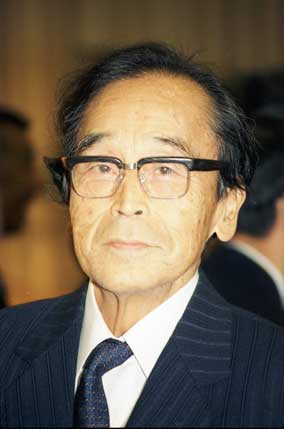 I used to be a school teacher, first at the elementary school level, then at a girls’ school, and then at the junior and senior high school and university levels. During that time, I often asked myself, “What is the most important thing I can impart to my students?” One of the answers I arrived at was “to appreciate, value, and honor one’s parents.” This conclusion was probably influenced, at least in part, by the general Japanese cultural value of taking one’s household and ancestors into consideration before thinking about oneself.
I used to be a school teacher, first at the elementary school level, then at a girls’ school, and then at the junior and senior high school and university levels. During that time, I often asked myself, “What is the most important thing I can impart to my students?” One of the answers I arrived at was “to appreciate, value, and honor one’s parents.” This conclusion was probably influenced, at least in part, by the general Japanese cultural value of taking one’s household and ancestors into consideration before thinking about oneself.
In my case, my father happened to be a skilled calligrapher, so I thought the best way to “honor” him, as it were, would be to take up the brush myself. Doing so became one of my goals in life. By coincidence my mother’s name happened to be “Fude,” which is also the Japanese word for “brush!” Anyway, it seemed apparent to me that part of my destiny lay in trying to make something of myself as a calligrapher.
My father had studied calligraphy under a well-known Osaka calligrapher by the name of Ekido Teranishi and therefore his style bore Teranishi’s influence to some extent and he became quite skilled. It occurred to me that I was probably the successor, and that is how I came to take up calligraphy myself.
Has calligraphy been a tradition in your family over the generations?
Yes, for quite a while it seems. Ever since I can remember practically every room in our house has always been decorated by the framed calligraphic works of previous generations.
2 – ENCOUNTER WITH MISOGI
I’ve heard that at one point in your calligraphy career you found yourself at something of a deadlock —a period of stagnation, if you will— and it was then that you discovered a group called the “Misogikai” that helped you break through that barrier. Could you tell us a bit more about that?
One’s growth as a calligrapher comes in a number of stages. To begin with, you learn how to work with the “form” or “shape” of the characters. Fortunately, there are so many examples of beautiful form —going all the way back to the Han Dynasty in China even— that there’s not much chance of stagnation when it comes to exploring form. Where I started to run into trouble was in my exploration of “line” (although “line” may be too simplistic a term), which is what you work on after you’ve mastered form to a certain degree. When it comes to line, concepts like “thickness” and “thinness” are easy enough to understand, but in addition to these you also have to work with “depth” and “shallowness.” Shallowness is easy enough to understand as well, so what I was having trouble with had to do with adding depth to my brushstrokes. Such depth is more or less invisible to the eye, yet it is still one of the qualities that gives life to a calligraphic work. So much so, in fact, that it may be considered the very heart and soul of Japanese calligraphy. The degree of thickness or thinness is a relatively visible quality that determines whether a line conveys the intended degree of energy or vigor, but qualities like depth (and also “height”) are invisible to the eye and therefore much more elusive.
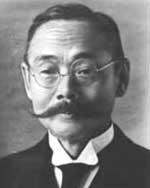
It was there that I found my growth as a calligrapher moving toward to an impasse. It was about that time that I first encountered Kenzo Futaki’s Misogi no Renseikai (Misogi Training Society). Kenzo Futaki was a Doctor of Medicine and a prewar student of Morihei Ueshiba. This Misogikai was a group dedicated to exploring and teaching methods that could be used to draw on a kind of “psychological” or “spiritual” strength beyond mere physical strength —what we might now call misogi (purification) to draw out”ki“. It sounded like exactly what I needed. The application date had already passed, but they made an exception for me, and I was able to join the first session, which was conducted as kind of “training camp” consisting of about a week’s worth of seminars.
Was the Misogikai the creation of Futaki Sensei himself?
Yes, he was the one who set it up, although the training methods taught were derived from those formulated by Bonji Kawatsura [philosopher who organized and formalized Japanese misogi practices], which were taught at the Misogikai by one of Kawatsura Sensei’s students, Ken Tatsumi.
What were some of those practices?
There are eight major ones. Standing under cold water (mizu no gyo) is one of the more well known. The eight include norito no sojo, mizu no gyo, furitama no gyo, ameno-torifune no gyo, chinkon no gyo, otakebi okorobi and ibuki no gyo, genshoku no gyo, and bunkon touitsu no gyo.
Are these practices related to the Omoto religion?
What Futaki Sensei and Kawatsura Sensei were doing was based not on religion, but on traditional Japanese customs and mores. Misogi practices are really nothing more than specific formalization of various customs commonly followed by the Japanese in their daily lives in ancient times. They are not, in other words, derived from Indian Buddhism or Chinese Confucianism, but from ancient Japanese practices that are clearly documented in works like the Kojiki (Records of Ancient Matters). Kawatsura Sensei’s work involved casting these in accessible forms that anybody can pursue.
Did Kawatsura Sensei ever author any books on misogi?
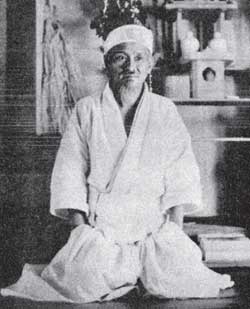
One of the best would be his ten-volume Bonji Kawatsura: Collected Works. Although it is written in the formal Chinese style (kambun), it is still probably the most accessible work on misogi for ordinary Japanese people. The treatment of the subject gives readers an excellent sense of what Kawatsura Sensei was all about, although, because he was a philosopher and a scholar of religion, the discussion becomes quite sophisticated and difficult to follow in places. Futaki Sensei, on the other hand, was a doctor trained in modern medical science, so he was easier to understand. He was also a scholar of the Kojiki and at the Misogikai, presented his interpretations of the Kojiki and the norito which are formulaic statements or prayers, formulated in classical language, addressed to the deities present at Shinto rituals.
Were those interpretations part of the seminar syllabus?
Yes. In fact, they were a primary focus of the seminar. In between cold-water training sessions, we listened to Futaki Sensei’s lecture on his interpretations of the Kojiki and the norito. The cold-water training lasted anywhere from thirty minutes to an hour, four times a day (once in the morning, twice in the afternoon, and once in the evening).
Futaki Sensei was also an enthusiastic advocate of eating unrefined brown rice. Reducing your consumption of food is one of the most difficult aspects of misogi practice, but it is considered quite important based on the idea that eating a normal amount limits your mind to having only normal thoughts. Brown rice is good for this because it’s one of the best foods you can give your body. The fact that it is unrefined puts it closer to living rice —it will sprout if you plant it, for example—, so eating just a little bit is enough. This “brown rice-assisted” reduction of food consumption comes first. Then you move into the cold-water training. Naturally pouring cold water over your body makes you cold, which leads then to the practice of <i<>furitama and, later, chinkon kishin. Altogether these comprise a set of practices toward a degree of enlightenment, toward the experience of a state of being of great spiritual height and depth that is inexpressible in words, a state of mind and being in which we truly know what it is to live and to be alive.
3 – MEET UESHIBA SENSEI
Did practicing misogi allow you to break through the deadlock you faced in your calligraphy?
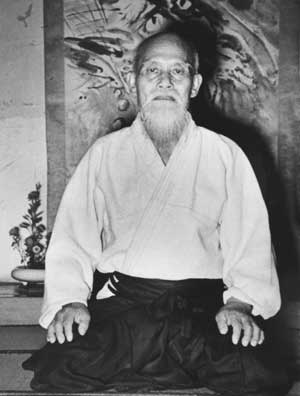
It changed my attitude and way of thinking about my calligraphy. It was also about the same time that Futaki Sensei recommended I take up aikido. He demonstrated a throw on me, and I was extremely impressed. He said, “Our nation is home to a budo as wonderful as this, and I strongly recommend that you take it up if you ever have the chance. You young people these days seem to have a few hoops loose, and I think it would do you good.” His technique was so impressive that I knew right then that aikido would be in my future, although I didn’t know how or when I would find a teacher. With the war growing more intense, Morihei Sensei rarely taught the general public, and spent most of his time teaching at places like the Toyama school and the Nakano school, special military institutions in Tokyo where he taught.
Your study of misogi and the Kojiki must have prepared you naturally to take up aikido. How did you finally meet Ueshiba Sensei?
Bansen Tanaka [1912-1988] opened an aikido dojo in Osaka in 1952. The day after the dojo opening, I happened to be passing by and noticed the name “Tsunemori Ueshiba” on the doorplate. Tanaka and I were acquainted, although I hadn’t known he did aikido. I saw that he was at home, so I went inside and said, “I noticed the name on the doorplate. Is Ueshiba Sensei really here? ” He replied that indeed he was, and that the dojo opening had been just the day before. Ueshiba Sensei himself came out a little while later, and that was the first time I saw him. When I introduced myself as a student of Futaki Sensei he took an immediate interest in me and told me to come right in. Then, he started talking about all sorts of difficult things about very sophisticated concepts having to do with chinkon kishin and so on. He went on like that for quite a while, and when he had finally finished he said, “That’s all for today. Come again tomorrow!”
And you became his student from that day forward?
Yes, and I consider myself very lucky, too, since during that period it was very rare for him to take on new students. At the time, he generally wouldn’t teach anyone who didn’t come with at least two formal introductions.
4 – INFLUENCE OF AIKIDO ON CALLIGRAPHY
What influence did practicing both misogi and aikido eventually have on your calligraphy?
The three converged into one for me. Aikido, for example, is ultimately not really about twisting wrists, causing pain, or throwing people; it is about cultivating “ki,” which is something distinctly different from these things. The same is true of calligraphy. There are five or ten thousand characters we can brush in learning about form and line, but ultimately we are pursuing something beyond these, and that something is none other than “ki” So calligraphy and aikido became the exact same pursuit for me and I began to practice both as hard as I could.
You once remarked that “the essence of calligraphy lies in kokyu. (lit. breath).” Is this the same sort of kokyu we find in aikido?
The very same.
This brings to mind the question, “What exactly are we teaching when we teach calligraphy?” We teach form and how to draw the characters, of course, but I think if we are unable to teach a certain “something more,” then the life will go out of calligraphy and it will no longer interest people.
That “something more” is very important, then, isn’t it?
It is indeed. Unfortunately, although calligraphy is quite popular these days, I have a feeling that most of it fails to offer the potential to discover this “something more.”
Would you say this is something you have to develop on your own, through sincere practice and by working through your own process?
Yes, and once you have it, you can start feeling out the range of your own skills by executing physically large pieces or by passing on what you have learned —what you have gleaned— to the next generation. In other words, at that point, your activities become focused on either challenging yourself through your works or placing yourself in a middle position from which to transmit what you have to others. Those are the two paths.
How was it that Morihei Sensei came to take up calligraphy?
I think he actually did a bit even before we met, although I doubt many of those works remain.
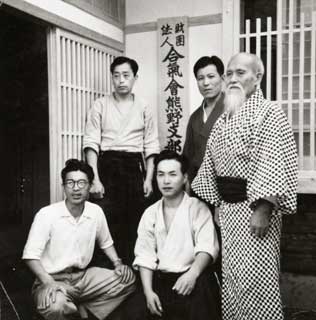
In 1954, I accompanied Morihei Sensei to Shingu to attend the opening of Michio Hikitsuchi’s dojo there. We stayed for about a month, and since Morihei Sensei hated seeing people idle, he told me to teach calligraphy in between aikido classes. A photographer by the name of Kubo got together a group of students, and suddenly I found myself with a part-time job!
Morihei Sensei would watch me teaching like that, and gradually began to take an interest himself. Before I knew it he was saying, “Well, perhaps I’ll do a few myself…”The first thing he brushed was the word “aiki,” although I’m not sure where that particular piece is now.
After we returned from Shingu, he started coming to my home and would always spend whole days practicing calligraphy. That seemed to be his greatest joy.
What was it like “teaching” your own teacher?
He was my aikido teacher, so naturally it was more or less unthinkable that I would “teach” him in the usual method of giving him a sample of my work to practice copying, I simply asked him politely to watch as I brushed the strokes.
Watching me he would always say things like,”Ah, yes, I see that you could write it like that!…”
One of the most difficult things was the fact that he would brush everything so fast that I had trouble clarifying the space for the signature. There’s only one suitable place for the signature, you see, so I tried to time it just right —using a kind of aiki, you know— to point out that spot in a way that would match his strokes perfectly and not interrupt the flow.
There is one unusual calligraphic piece that Morihei Sensei did using his finger instead of a brush. Examples of finger-painted ink paintings do exist, so I think he must have heard about these, and decided he wanted to try the same in his calligraphy. Most people would not have thought of doing such a thing.
Morihei Sensei had a certain tension in him whenever he took up the brush, I think because he always expressed his entire being through the tip of the brush. Using the ink as a medium, he transferred his ki into the characters as he brushed them. Look at his works today and you can immediately sense the amazingly strong ki imbued in them. Interestingly, it is foreigners who cannot read Japanese characters who seem to perceive this ki most strongly.
Ueshiba Sensei’s spirit resides in his calligraphy not in the forms or shapes of the characters, but in their resonance and light. Similarly, that spirit resides in aikido not in the techniques you can see with your eyes, but in those you cannot.
Morihei Sensei always executed his calligraphic works in a single spell, but also without thinking overly much about his breath (kokyu). It was the same in performing exercises like furitama and otakebi [in Shinto, vigorous shouting for the purpose of summoning deities]. He always told us to simply take about three breaths before beginning furitama, the point being that instead of acting without awareness, you should first settle your breath in your center (hara). This emphasis on setting the breath in the hara is something that ties together calligraphy and aikido.
5 – UCHIDESHI IN MY OWN HOME
Did you begin your aikido career as an uchideshi?
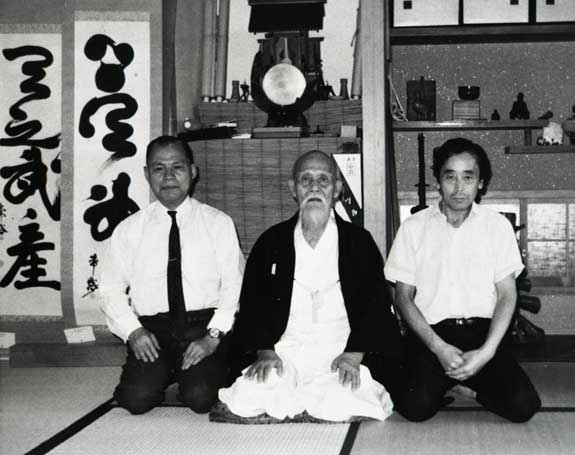
Samples of Morihei’s calligraphy are to the left.
Yes, in a way, but actually it was Morihei Sensei who would come to my home —to practice calligraphy, as I mentioned— instead of the other way around. This put me in the rather unusual position of being uchideshi in my own home! We had a special room set aside for him, and it was there that we developed our relationship as student and teacher. Nonetheless, it was very much an old-style student-teacher relationship rooted in strict bushido attitudes. The discipline was not externally imposed, however, but came rather from the attitudes and behaviors to which any uchideshi naturally subjects himself out of a desire to serve his teacher. This is really the only way to truly grasp and absorb your teacher’s “kokyu.” Living with your teacher under the same roof twenty-four hours a day gives you access not only to his technical abilities, but also to an understanding of the very way he lives and breathes, his way of life and his rhythms. It is an opportunity to train and discipline your ki, and in the process to know all of the sides of your teacher. Morihei Sensei used to visit for a week or ten days at a time, and being in such close contact with his very life and being for such extended periods was a truly amazing and precious experience.
For example, when preparing tea, I had to sense or judge just how thirsty he was and adjust the temperature accordingly. Or in preparing his bath, I had to be very careful to make the water temperature just right -and not simply by sticking my hand in to test it directly-, but by taking some in a pail and judging from that. If I put my hand in directly, a little bit of oil from my skin would come off in the water and somehow he’d know about it. In other words, serving one’s teacher means being sensitive and conscientious and doing things properly and appropriately, without taking shortcuts. Even when sleeping in an adjacent room, my breath had to be matched with his at all times. Such experiences are the amazing part about being an uchideshi.
Was Morihei Sensei influenced in his diet at all by Futaki Sensei’s recommendation to eat brown rice?
He always ate brown rice whenever he stayed at my home. Futaki Sensei once told me that if ever I had the opportunity I should have Morihei Sensei eat brown rice. When I mentioned this to Morihei Sensei he just said, “I see…”, and from then on ate brown rice whenever he stayed with us.
6 – THE KOJIKI
Do you interpret aikido based on your studies of the Kojiki?
I personally have not yet made any of my own decisive interpretations of the Kojiki. There are many people who have come to learn from me, but I hardly ever talk about the Kojiki in teaching them aikido. Take the idea of Ame no Minakanushi. Someone given to a religious perspective would probably view Ama no Minakanushi as a specific deity to be worshipped. But as a modern Doctor of Medicine, Futaki Sensei avoided this kind of idolatry. Instead of talking about such things in terms of kotodama, he interpreted them in more modern language. His interpretation of Ame no Minakanushi, for example, went like this: Ame, literally meaning “heavenly” or “divine,” is simply a term of respect; no is a simple grammatical connector; Mi is a respectful prefix. That leaves naka (center, middle) and nushi (lord, holder of). He felt, therefore, that Ame no Minakanushi does not represent some specific deity observing us from some divine perspective in the cosmos, but that it refers instead to the very first ancestor of our nation who, according to Futaki Sensei, taught the idea of “the importance of the center” (the center being something that every living human being has).”Understand that center and cherish it” was his interpretation. He spoke of aikido as being circular movement, saying that one must find the center and lead all into the circles that surround it. The modern aikido we practice today is no different in the sense that we teach people to be their own centers, to work with centrifugal and centripetal forces to draw their partner into or around that center, thereby coaxing and cajoling the attacker into a position that allows him to be controlled. These circles can also be taken into three-dimensional form to become spirals. In any case, Ame no Minakanushi is the individual who taught that “the centers of things are important.”
This idea holds true across many aspects of daily life. Think about who is at the center of a typical (traditional) Japanese home, for example. In the morning, the wife is the center at first as she arises and begins preparing breakfast. Then the husband comes to the table, and he becomes the center as he eats and prepares to leave for work. The center then shifts to the children as they get ready to go off to school. Once everyone has left the house, the wife once again becomes the center as she takes care of the daily household business.
Another example would be the three of us participating in this interview. Since I’m the one speaking at the moment, I am Minakanushi. When you respond or ask another question, then you become that center. The center, in other words, is something that shifts. So Ame no Minakanushi represents not any specific deity or idol, but rather this concept of the importance of the center. This was an example of Futaki Sensei’s interpretation of the Kojiki.
Would it be correct to say that the Kojiki was at the core of O’Sensei’s thinking?
Yes, at least in terms of explaining technique. Also, the Kojiki is one of the only things in Japan that is nearly absolute and unchanging, containing as it does the Shinto traditions and transmissions of the Japanese people as a nation. The essence or path of Japan is represented in the Kojiki, particularly in the tales up to Izanagi no Mikoto and Ama Terasu O-Mikami. That in which we can believe most strongly is contained in the legends describing Ame no Minakanushi through the first seven divine generations of the age of the gods. A close reading of these will show that Onisaburo Deguchi Shoshi’s [1871-1948, co-founder of the Omoto religion] interpretations were quite appropriate, at least in terms of the spirit which is present in words.
It would have been quite interesting to hear a discussion of the Kojiki between Futaki Sensei and Ueshiba Sensei, don’t you think?
It certainly would have been. I think it would be very easy for someone with a background in the Omoto religion interpretations of the Kojiki to understand Futaki Sensei’s interpretations and vice-versa. Someone with an understanding of Futaki Sensei’s interpretations of Minakanushi as “center” would have no trouble understanding the kind of “center” Onisaburo Deguchi Shoshi spoke of. The only essential difference is that Futaki Sensei’s interpretations came from a scientific perspective instead of a religious one. Morihei Sensei and Futaki Sensei differed in this way in their interpretations of the Kojiki, although I don’t think they ever discussed these differences.
Did Ueshiba Sensei ever talk about his experiences in Hokkaido?
He often talked about misogi in Hokkaido. He mentioned performing cold-water ablutions in temperatures well below freezing, saying that while he had to work hard to cut a hole in the thick ice the first day, the ice in that same area was thinner the next day so it was not as difficult.
7 – UESHIBA SENSEI’S DOKA
I understand you’ve done extensive study of Ueshiba Sensei’s doka (lit., “Songs of the Way”). Perhaps you could give us an overview of how we may best understand Ueshiba Sensei in light of these verses?
One thing I’ve noticed is that there is a certain consistency of focus running through O’Sensei’s doka, a consistency that suggests it may be better to avoid dividing them —as has been done in the past— into prewar and postwar doka. They are focused not so much on people or things in the human sphere as they are on the universe itself, and on offering clues as to how to be in harmony with that universe. This is certainly true of the postwar doka, but the prewar doka are also characterized by this focus. The doka from both periods express the idea that “bu (the martial) is love” (“bu wa ai nari“) and interpret the sword as “the life-giving sword (katsujinken).”This idea of the martial as a manifestation of the qualities of love and harmony is consistent throughout O-Sensei’s doka.
Did O-Sensei often compose his doka as brushed calligraphic works?
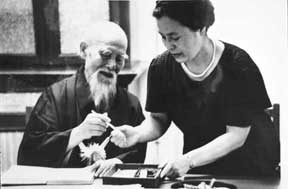
Sunadomari who prepares his brush
No, most often he wrote them with a pen in one of the small notebooks he used to carry in his bag. One of these remains in my home even now and I treasure it greatly. He had very skilled handwriting. Morihei Sensei started keeping a diary from around the time of his enlightenment experience by the side of the well to around the end of the Taisho era [1912-25] and he continued with it for many years. Being deeply learned, he used a style of script known in Japanese calligraphy as “hentai kana,” an anomalous cursive-style syllabary.
Morihei Sensei’s doka are filled with references to Omoto theology, but their essential spirit goes beyond Omoto to embrace the Japanese “spirit of harmony,” and also the kotodama wa (a word for harmony). Consequently, I think it better to view and understand these in a historical rather than a religious context.
The enlightenment that Morihei Sensei achieved through his training broadened him greatly, as a human being and a martial artist, and this growth shows up consistently in the seven or eight different themes he addressed in his doka, one of which, for example, makes reference to “the divine techniques of Odo.” Morihei Sensei’s study of Daito-ryu and his involvement in the Omoto religion obviously influenced him greatly, but I suspect that the misogi training he pursued from a very early stage was also of paramount importance in making him who he was as a man and as a martial artist. He suggested this himself in statements like “aikido is misogi.” Put slightly differently,” aikido is the divine techniques of Odo.” [According to the Kojiki, Izanami no Mikoto, escaping from the world of death, performed ritual purification in Awagihara by the Odo (lit., “narrow river mouth”). When he threw off his impurities, Some kami or “deities” were born. Then, when he entered into the water and purified himself, more kami were born. O-Sensei said that aikido was born as a result of the thrashing about of Izanagi no Mikoto during his purification.] In my view, Morihei Sensei’s lifelong pursuit was essentially the pursuit of the divine techniques of Odo.
Do you have any specific plans to help keep the spirit of O’Sensei alive so that others may continue to know and experience it?
I feel very indebted to O-Sensei and also happen to have many of his calligraphic works in my possession, so I’ve been considering publishing these in some kind of posthumous collection. I’ve already drafted a text for this under the supervision of Kisshomaru Sensei, but there remain a number of items I would still like to add. Unfortunately, I keep getting sidetracked and can’t seem to make much progress, but eventually I hope to publish these works by Morihei Sensei so that aikido practitioners around the world may draw inspiration from them and also get a sense of who and what Morihei Sensei was.
After that I hope to house these works in some sort of memorial museum so that aikido practitioners from around the world can have an opportunity to get to know them first-hand. They are simply too precious to be sequestered away out of sight. I would like to make them accessible so that everyone may have a chance to view them and absorb all that they have to offer.

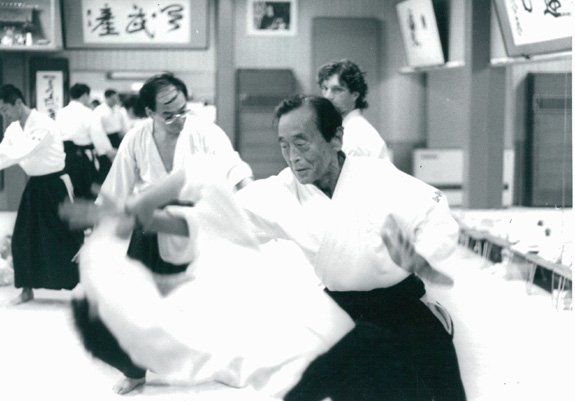











Add comment